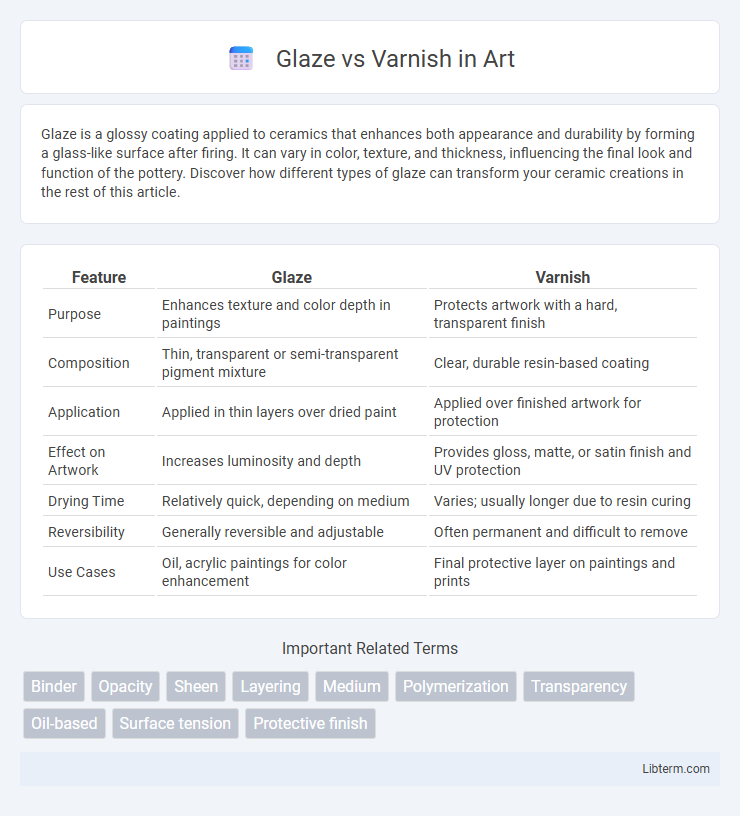Glaze is a glossy coating applied to ceramics that enhances both appearance and durability by forming a glass-like surface after firing. It can vary in color, texture, and thickness, influencing the final look and function of the pottery. Discover how different types of glaze can transform your ceramic creations in the rest of this article.
Table of Comparison
| Feature | Glaze | Varnish |
|---|---|---|
| Purpose | Enhances texture and color depth in paintings | Protects artwork with a hard, transparent finish |
| Composition | Thin, transparent or semi-transparent pigment mixture | Clear, durable resin-based coating |
| Application | Applied in thin layers over dried paint | Applied over finished artwork for protection |
| Effect on Artwork | Increases luminosity and depth | Provides gloss, matte, or satin finish and UV protection |
| Drying Time | Relatively quick, depending on medium | Varies; usually longer due to resin curing |
| Reversibility | Generally reversible and adjustable | Often permanent and difficult to remove |
| Use Cases | Oil, acrylic paintings for color enhancement | Final protective layer on paintings and prints |
Introduction to Glaze and Varnish
Glaze is a translucent or transparent layer applied over paint to create depth, richness, and a textured finish by allowing the underlying color to show through. Varnish is a clear, protective coating used to seal and preserve surfaces, enhancing durability and adding a glossy, satin, or matte finish without altering the color beneath. Both glaze and varnish serve distinct functions in art and woodworking, with glaze primarily enhancing aesthetics and varnish providing protective benefits.
What Is Glaze?
Glaze is a translucent or semi-transparent coating applied over paint or finish to create depth, texture, and enhanced color variation on surfaces such as wood, walls, or ceramics. Unlike varnish, which is primarily a clear, protective topcoat, glaze modifies the appearance by emphasizing details and adding richness without providing significant protection. Glaze formulas often mix pigments with a binder, enabling decorative effects like antiquing, shading, and highlighting architectural elements.
What Is Varnish?
Varnish is a transparent, protective finish applied to wood surfaces to enhance durability and resistance against moisture, UV rays, and abrasion. It forms a hard, glossy coating that seals the wood while preserving its natural texture and color. Unlike glaze, which adds color and texture effects, varnish primarily focuses on long-lasting protection and a smooth, clear finish.
Key Differences Between Glaze and Varnish
Glaze creates a translucent layer that enhances texture and depth on surfaces, while varnish forms a clear, protective coating that seals and shields against damage. Glaze is typically used for decorative purposes to add richness and dimension in painting and finishing, whereas varnish prioritizes durability and surface protection in woodworking and furniture. The chemical composition of glaze usually involves pigments suspended in a medium, contrasting with varnish's resin-based formula designed for hardness and longevity.
Common Applications of Glaze
Glaze is commonly applied in pottery and ceramics to create a glossy, protective coating that enhances color depth and surface texture. In woodworking, glaze accentuates grain patterns and adds an aged or antique finish, often used on furniture and cabinetry. In painting, glaze layers help modify tone and color intensity, producing rich visual effects in oil and acrylic artworks.
Primary Uses of Varnish
Varnish is primarily used to protect wood surfaces by providing a durable, transparent coat that enhances natural grain while resisting moisture, UV rays, and wear. It is commonly applied on furniture, flooring, and exterior woodwork to extend lifespan and maintain aesthetic appeal. Varnish's film-forming properties make it ideal for creating a hard, glossy finish that safeguards against scratches and environmental damage.
Advantages of Using Glaze
Glaze enhances depth and richness by penetrating surface textures, creating a multidimensional finish that cannot be achieved with varnish alone. It offers superior control for artists and decorators, allowing for subtle color variations and customized effects through layering and blending. Glaze also provides flexible durability, improving resistance to wear while maintaining a softer, more natural appearance compared to the often rigid, glossy protection of varnish.
Benefits of Applying Varnish
Varnish enhances wood surfaces by providing a durable, protective barrier that resists moisture, UV rays, and wear, extending the lifespan of furniture and flooring. It offers a glossy or matte finish that highlights the natural grain and color of wood, improving aesthetic appeal while preventing scratches and stains. Varnish's superior sealing properties help maintain the integrity of interior and exterior woodwork, reducing maintenance and repair costs over time.
How to Choose Between Glaze and Varnish
Choosing between glaze and varnish depends on the desired finish and protection level for a surface. Glaze enhances texture and adds depth with a translucent, decorative layer, ideal for artistic and furniture projects, while varnish creates a hard, durable, and clear protective coat suitable for high-traffic or outdoor surfaces. Consider the surface material, exposure to wear and moisture, and whether the goal is decorative enhancement or long-lasting protection to make the best choice.
Conclusion: Glaze vs Varnish – Which Is Best?
Glaze enhances depth and texture by adding translucent color layers, ideal for decorative finishes and artistic effects, while varnish provides a durable, protective coating that resists moisture and wear, perfect for preserving surfaces. Choosing between glaze and varnish depends on whether the primary goal is aesthetic enhancement or surface protection. For long-lasting durability with minimal maintenance, varnish is best; for rich visual complexity and design, glaze offers superior artistic benefits.
Glaze Infographic

 libterm.com
libterm.com